From Dave Brigham:
Last month I visited Chicago with my family during school vacation week. In late April I posted about the backside elements I found in the Windy City (see April 28, 2018, "Toddling Around Chicago"); today's post is about the river tour we took that showcases the diverse and wonderful architecture in the city (and some backside stuff, of course). Astute blog readers will recall that my first post more than eight years ago talked about how my interest in the backside of America was inspired in part by a childhood canoe trip I took with my father down the Farmington River in my Connecticut hometown (see March 1, 2010, "Take Me to the River").
Run by the Chicago Architecture Foundation, the cruise runs about 90 minutes and goes along the Chicago River and briefly into Lake Michigan.
OK, let's get this first building out of the way.

This is Trump Tower Chicago, which our well-versed and perfectly charming docent told us is the most beautiful building in all of Chicago, perhaps the world. Actually, that's fake news. At 98 stories it is far shorter than President Donald J. Trump (R - Idiotville) wanted it to be 20 years ago. After the 9/11 attacks, however, he scaled back his vision of constructing the tallest building in the world.
The next buildings are incredibly different from Trump Tower and every other building we saw.

Marina City, a mixed-use residential/commercial building that was memorialized on Wilco's Yankee Hotel Foxtrot album -- was built in 1968 and includes a hotel, a House of Blues club and several restaurants. The lower third of each building comprises a spiral parking garage. Too cool.

Built in 1914, the Reid, Murdoch & Co. building has served over the years as offices, a grocery warehouse, home to Chicago's traffic courts and more. The penthouse is now occupied by The World of Whirlpool, the "international brand and product experience center" for the home appliance company. There is a restaurant called River Roast on the ground floor.
There are 37 moveable bridges on the Chicago River, and even more bridge houses. For more than a century, these houses were staffed 'round the clock by tenders, who opened and closed the bridges every day to allow boats and ships through, maintained the infrastructure and lived on site. Nowadays, the bridges are opened just a few dozen times a year, to "let recreational sailboats with soaring masts pass between their summer and winter berths," per this Chicago Tribune article.
I fell in love with several of the tender houses during our trip, and put the McCormick Bridgehouse & Chicago River Museum on my list of things to do. Alas, the museum was closed while we were in Chicago. For more words about and photos of the bridge tender houses, read this Untapped Cities article.
OK, let's get to my photos of the houses.

(This is the LaSalle Street house. Built in 1928, it is one of four at this bridge; most bridges only have two houses.)

(The Grand Avenue bridge house is my favorite. I didn't see any others of this style, and certainly not of this color. I can picture a hipster family living in here. The city rebuilt this house, along with some others, to restore it to its original wooden design, according to this book entry.)


(The Chicago Avenue bridge houses aren't the prettiest, and neither are these photos. Here's a better image of the second one. I find it interesting that they don't match. They are located on opposite sides of the river, and the bridge.)

(The Lake Street bridge house opened in 1916, and tends what was the world's first double-decked trunnion bascule bridge, according to this article. Trains cross the bridge's upper deck, and cars the lower.)

(The Roosevelt Road bridge was the turnaround point for our cruise. The bridge house was built in 1929, according to this web site, and rehabbed in 1994.)

(The Van Buren Street bridge house went up in 1956, the year the sixth iteration of the bridge was built, per this web site.)

(The Jackson Boulevard bridge opened in 1916, so I assume the house did as well.)

(The Adams Street -- aka Historic Route 66 -- tender house was built in 1927.)

(The raised bridge in the background is known alternately as the Carroll Avenue railroad bridge (more about Carroll Avenue here) and the Kinzie Street railroad bridge (read this). Owned by the Union Pacific railroad, the bridge is evidently lowered once a year to be inspected by a crew in a Hi-Rail truck.)
You can learn more about the dozens of Chicago River bridges at this link.
OK, enough bridges....

(One of my favorite buildings along the river cruise is Fulton House. Formerly a cold storage warehouse, it has four-foot-thick walls and was converted to residences in the late '70s.)
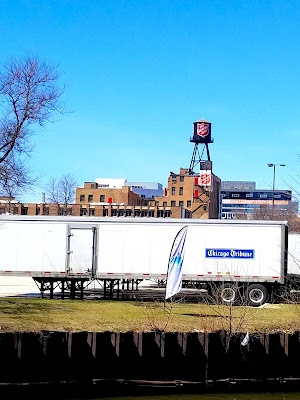
(When I visit New York City I'm always pleasantly surprised at the number of roof-top water towers still in place. I didn't see nearly as many in Chicago, but I was happy to see the Salvation Army one hanging on. The charity organization received a permit last year to repair the tank.)

(The Spirit of Progress statue in the middle of this photo sits atop the former Montgomery Ward headquarters. The Groupon building was a Montgomery Ward warehouse.)

(I really like this photo. The reflection, the mix of old and new, the river and the elevated train, the beautiful brick building that was built by renowned architect Daniel Burnham in 1922 as offices and warehouse space, and which was turned into condos called Randolph Place.)
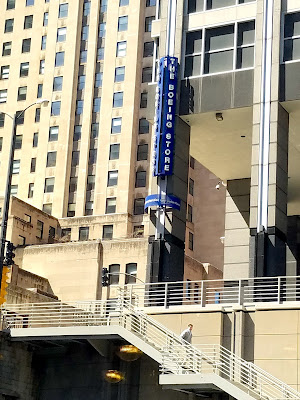
(I took this photo mainly as a way to remind myself to ask my son, an aviation enthusiast as well as a train lover, if he wanted to visit the store at Boeing International Headquarters [He was topside and I was belowdecks with my daughter]. He didn't. But I learned while writing this that the building, which was erected in 1990, is the former world HQ of Morton Salt.)
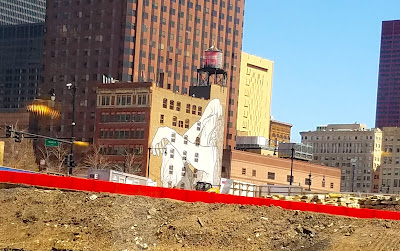
(The mural is what caught my eye. It was painted by French duo Ella & Pitr, according to the Facebook page of Joseph Cacciatore & Co. Real Estate, on whose building the art is situated. Known as "The Native American Lost in Chicago...Dreamin'," the mural is one of two the artists have completed in Chicago. My daughter, with her young eyes, was able to tell me that the classic water tower on the roof read "Cacciatore." If not for her, I probably wouldn't have been able to determine much about this site.)
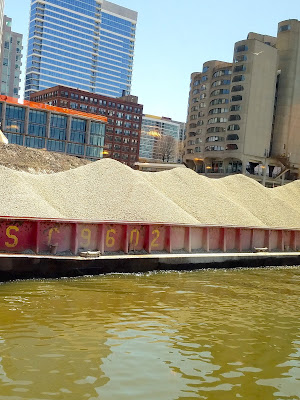
(I was surprised to see a barge on our cruise, but I shouldn't have been. Once this would have been a common sight.)

(The cruise turned around at the Union Power Station.)

(I know I missed a LOT of ghost signs in Chicago, even in the relatively small area of the city we visited. I spied this one, though, on the Paper Place Lofts building, which was built in 1915 and is the former home of the Chicago Paper Company.)
We cruised back toward our starting point, and then continued on toward Navy Pier, a shopping, eating and entertainment destination. I put this place on my pre-trip list of things to do, but it was just too damn cold to go out there.

(Maybe next time we'll make it to the Navy Pier's Ferris wheel, which made its debut during the 1893 Chicago World's Fair.)

(Not a bad view, eh?)
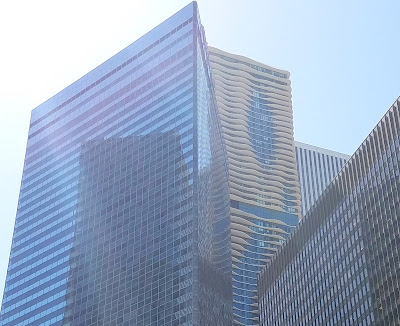
(The skyscraper in the middle of this photo, the one that looks like it has a vertical eye, is known as Aqua. A mix of retail, office, residential and hotel space, the 82-story building was erected in 2009. It's not old but I really like it.)
Finally, the LondonHouse Chicago hotel.
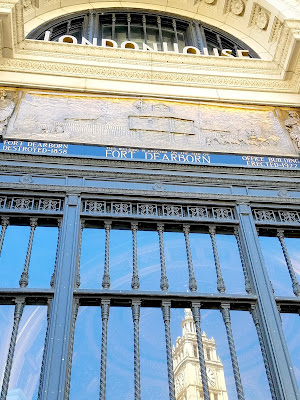
(I took this photo after the cruise, as we were hustling through the cold toward lunch at the Windy City's outpost of Elephant & Castle. Built in 1923 and originally known as the London Guarantee Building, LondonHouse is located on the site of the long-gone Fort Dearborn.)
I'm happy with the two posts I've done about Chicago, but wish I had more! With the Windy City stuff done, and warmer weather upon us here in New England, I plan to get back to my ongoing chronicle of my adopted hometown of Newton, Mass.































